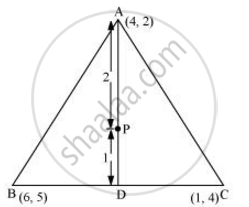Advertisements
Advertisements
प्रश्न
Let A (4, 2), B (6, 5) and C (1, 4) be the vertices of ΔABC.
(i) The median from A meets BC at D. Find the coordinates of point D.
(ii) Find the coordinates of the point P on AD such that AP: PD = 2:1
(iii) Find the coordinates of point Q and R on medians BE and CF respectively such that BQ: QE = 2:1 and CR: RF = 2:1.
(iv) What do you observe?
(v) If A(x1, y1), B(x2, y2), and C(x3, y3) are the vertices of ΔABC, find the coordinates of the centroid of the triangle.
उत्तर

(i) Median AD of the triangle will divide the side BC into two equal parts.
Therefore, D is the mid-point of side BC
Coordinate of D = ` ((6+1)/2, (5+4)/2) = (7/2, 9/2)`
(ii) Point P divides the side AD in a ratio 2:1.
Coordinate of P =`((2xx7/2+1xx4)/(2+1), (2xx9/2+1xx2)/(2+1))= (11/3, 11/3)`
(iii) Median BE of the triangle will divide the side AC into two equal parts.
Therefore, E is the mid-point of the side AC.
Coordinate of E =` ((4+1)/2,(2+4)/2) = (5/2, 3)`
Point Q divides the side BE in a ratio 2:1.
Coordinate of Q =`((2xx5/2+1xx6)/(2+1), (2xx3+1xx5)/(2+1)) = (11/3,11/3)`
Median CF of the triangle will divide the side AB in two equal parts. Therefore, F is the mid-point of side AB
Coordinate of F =`((4+6)/2, (2+5)/2) = (5, 7/2)`
Point R divides the side CF in a ratio 2:1.
Coordinate of R =`((2xx5+1xx1)/(2+1),(2xx7/2+1xx4)/(2+1)) = (11/3, 11/3)`
(iv) It can be observed that the coordinates of point P, Q, R are the same.
Therefore, all these are representing the same point on the plane i.e., the centroid of the triangle.
(v) Consider a triangle, ΔABC, having its vertices as A(x1, y1), B(x2, y2), and C(x3, y3).
The median AD of the triangle will divide the side BC into two equal parts. Therefore, D is the mid-point of side BC.
Coordinate of D =`((x_2+x_3)/2,(y_2+y_3)/2)`
Let the centroid of this triangle be O.
Point O divides the side AD in a ratio of 2:1.
Coordinate of O = `((2xx(x_2+x_3)/2+1xxx_1)/(2+1), (2xx(y_2+y_3)/2+1xxy_1)/(2+1))`
`= ((x_1+x_2+x_3)/3, (y_1+y_2+y_3)/3)`
APPEARS IN
संबंधित प्रश्न
Find the area of the quadrilateral whose vertices, taken in order, are (-4, -2), (-3, -5), (3, -2) and (2, 3).
The four vertices of a quadrilateral are (1, 2), (−5, 6), (7, −4) and (k, −2) taken in order. If the area of the quadrilateral is zero, find the value of k.
Prove analytically that the line segment joining the middle points of two sides of a triangle is equal to half of the third side.
If the coordinates of the mid-points of the sides of a triangle are (1, 1), (2, —3) and (3, 4), find the vertices of the triangle.
Find the area of a triangle whose sides are respectively 150 cm, 120 cm and 200 cm ?
Find the area of a triangle two sides of which are 18 cm and 10 cm and the perimeter is 42cm ?
A field is in the shape of a right angled triangle whose base is 25 m and height 20 m. Find the cost of levelling the field at the rate of ₹ 45 per sq.m2
Let ∆ = `|("A"x, x^2, 1),("B"y, y^2, 1),("C"z, z^2, 1)|`and ∆1 = `|("A", "B", "C"),(x, y, z),(zy, zx, xy)|`, then ______.
If A, B, C are the angles of a triangle, then ∆ = `|(sin^2"A", cot"A", 1),(sin^2"B", cot"B", 1),(sin^2"C", cot"C", 1)|` = ______.
The area of the triangle whose vertices are A(1, 2), B(-2, 3) and C(-3, -4) is ______.
